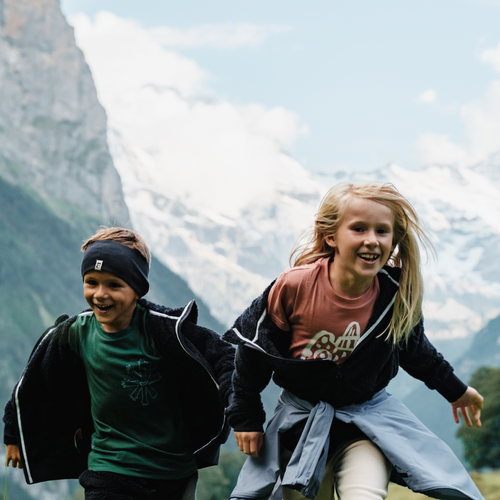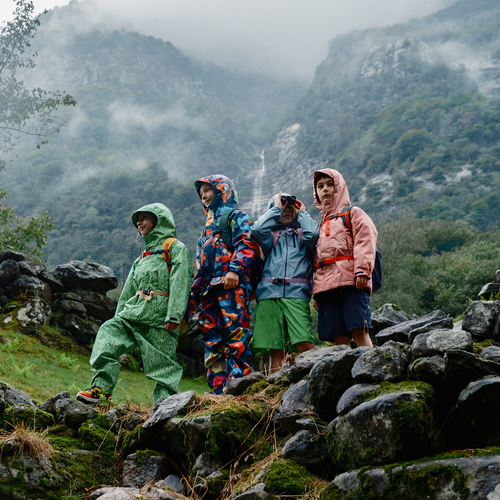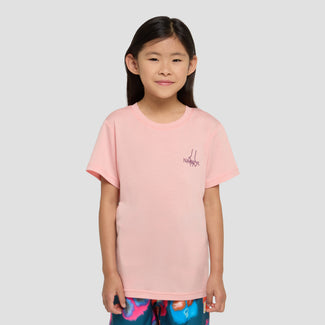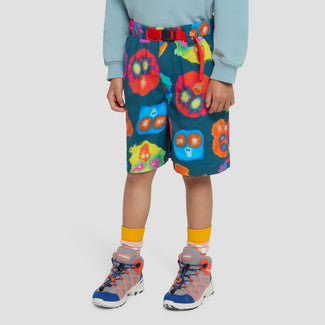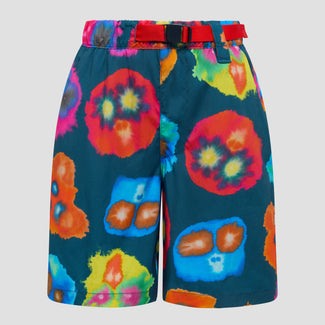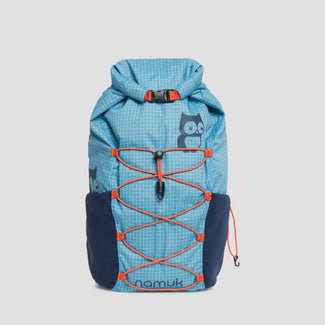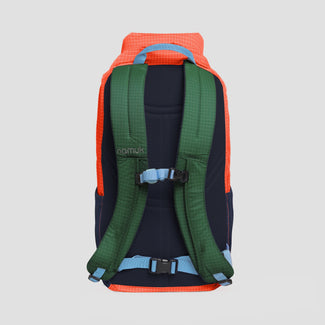What transforms a simple piece of clothing into something truly extraordinary? Is it the fabric? The cut? The design? For us, it’s one thing above all: the epic adventures each garment carries within its fibers. Stories of dancing in the rain, cooking with mud, playing hide-and-seek, conquering mountain peaks – and the beautiful journey of passing these adventures from one young explorer to the next.
As we celebrate World Environment Day, we’re embarking on an exciting new expedition called “Behind the Product.” Join us as we venture behind the scenes of our product development, revealing how sustainability is incorporated at namuk – from the very first spark of an idea to the final stitch. We’re not claiming to be perfect, but we’re blazing this trail with unwavering conviction. We’re starting with a topic close to our hearts: ReUse & Repair. Our gear isn’t designed to survive just one expedition – it’s crafted to last countless adventures. So, what happens when young adventurers outgrow their trusty gear? Or, when it gets damaged? We mend. We collect. We pass them on.
Discover how this magical cycle works through the eyes of Anna and Chiara from our Product Team, alongside namuk founder Franz. Why we choose to repair rather than replace? What makes our ReUse platform so special? And why durability isn’t just our destination but the very foundation of our adventure?

Why We Take Back, Mend, and Pay It Forward
What happens to clothes that children have outgrown? Answer: usually… nothing. Too often, they are forgotten, tucked away in drawers, stored in mysterious boxes, suspended somewhere between “too precious to discard” and “perhaps someone might need this someday.” But that didn’t feel right to us.
So, we asked ourselves: What if the adventure simply continues? This idea led us to taking back these treasured pieces, breathing new life into them, and paying them forward. Because we believe: What lasts long should live long – ideally accompanying several young explorers on their childhood adventures.
“Extending the lifespan of clothing is the best way to reduce CO₂ emissions in the textile industry,” Franz, namuk’s founder, explains. “Up to 78% of emissions emerge during production when the garment is first made." Since we believe authentic sustainability begins where decisions are made, our mission became crystal clear: If we’re making something, it should have a long future ahead. And if it gets damaged? Then we mend it.
But we couldn’t stop at mere repair. In 2021, we launched our ReUse platform. “What started as a small side project has evolved into a core element of namuk – and our customers appreciate it," Franz says. A cycle that allows clothing to live on. Along with the adventures they become a part of.

How ReUse & Repair Works at namuk
You bring the piece of clothing back to us. We’ll take a look at it, patching it up as needed before sending it off on new adventures. Because somewhere, the next little explorer is already waiting to roam through the forest, build dens, or dance in the rain.
“With ReUse, we want to create an incentive to keep our products in use for as long as possible,” Anna explains. It works like this: clothes that have become too small but are still in good condition can be sold back to us.
Following a quality check by our team, you will receive 20% of the original purchase price as a namuk voucher. Regardless of whether the item is as good as new or a bit worn. The only thing that matters is that it is still functional – and ready for a second or third round.
We don’t provide a voucher, for heavily worn or damaged items that we can no longer offer through ReUse – but there’s still a happy ending: we repair them at our own expense and donate them to a children's home in Romania.

Unfortunately, we can’t accept certain products for ReUse due to hygiene reasons – these include merino clothing (underwear, base layers), accessories, shoes, gloves, hats, beanies and socks. However, we will donate them if possible.
And when you buy ReUse items from us, you can be certain that all items have been thoroughly checked, lovingly refurbished, and are described honestly – no matter whether they are as good as new, in good condition or with a few visible signs of wear. Technical flaws aren’t a thing with us.
We handle smaller repairs like holes or tears in-house – with meticulous care and sometimes a patch that tells its own beautiful story. If necessary, the items are washed, waterproofed, or treated for stains. Larger repairs journey to our trusted partners at Transa in Zürich Altstetten – in order to fix open seams, reattach coat hooks, or mend worn snow guards among other things.
Our motto: it is better to repair and return items to the cycle than to throw them away. Because every item that is worn again saves precious resources – and writes new chapters in the outdoor life of another young explorer.

Created for Durability – Why ReUse Thrives at namuk
Because we consider how each item of clothing could be returned. Because our materials can withstand far more than you would think. Or perhaps because young adventurers often prefer to wear the things that arrive with a few scratches and stories already woven into their fabric.
Whatever the reason – ReUse works. Because at namuk, we focus on durability right from the start. “When choosing materials, we always look for quality,” Chiara says. “We source fabrics that others utilize for adult clothing or workwear.” That these materials are not just suitable but perfect for young explorers becomes evident through our rigorous testing process. Laboratory tests measuring tear resistance and abrasion reveal that our fabrics are up to ten times more durable compared to our competitors. All while maintaining the softness that makes them ideal for kids. “Developing such fabrics is the key,” Franz notes.
Did you know? Children’s clothing faces extraordinary challenges due to crawling expeditions, climbing adventures, and frequent washing – thus, demanding materials that are soft, durable, and can keep up with endless adventures.

We also look closely at processing. Additional straps at high-stress points, seams that hold – and fabrics that have already gone through lab trials before facing their ultimate test conducted by our mole crew. Furthermore, we use zippers from YKK, the world’s largest zipper manufacturer. “We’re currently testing rain pants with shifted seams,” Chiara says. “We’re hoping that this will make them less likely to get holes in susceptible areas.”
And if clothing lasts a long time, it can also be passed on. With visible marks – and at times even little surprises. “ReUse items often arrive with their own unique stories,” Anna shares. “They’ve been on numerous previous expeditions. Former adventurers sometimes immortalize their names inside their jackets. Other items have been mended with a little owl or a patch.”
Some customers are looking for precisely that: something that is no longer brand new – but unique. On our ReUse platform, you can always find pieces that are one of a kind. Items from previous collections that are no longer in production. Small findings with a story.
And by the way: ReUse items cost 20% to 50% less compared to retail prices. They’re often more affordable than on other second-hand platforms. But with guaranteed quality. And without any hidden flaws. On top of that, ReUse clothing can also be returned once it no longer fits.

Price Per Year – Why Quality Pays Off
But it’s not just about jackets or pants. It’s about time spent in the great outdoors. After all, how useful is an inexpensive piece of clothing if it wears out after one winter or maybe even four weeks? If it tears during the first climbing adventure, loses its shape after the second wash, or simply can’t keep up with the third kid?
Did you know? According to studies, a jacket that was worn three times longer saves up to 7 kg of CO₂ equivalents. As an example, a namuk mission jacket saves 3.2 kg of CO₂ – simply by lasting longer.¹
This is why we view every piece not in seasons or trends, but in years. A jacket that lasts four winters isn’t four times more expensive – it’s four times more useful. Put another way: It’s an investment that pays over time – both ecologically and financially. The technical term is the “Total Cost of Ownership.” At namuk, we call it: Buy less. Use more. Pass it on instead of discarding it – and reduce the need for constant replacements.

“Our mission is crafting high-quality, functional garments combined with a unique design,” Chiara explains. This journey begins not with logos but with the choice of fabrics – and those crucial details you only notice when you need them most: sealed seams, additional straps, zippers that endure every possible adventure. "Quality has its price, and we gladly invest in longevity," Chiara continues. And this commitment resonates far beyond our company. In a survey among our customers, 87% confirmed they could easily pass on or resell their namuk clothing – because even after years of adventures, it remained in good condition.
When you divide price by lifespan, the costs are often lower than those of cheap alternatives. Families with several kids are quick to realize this: a quality jacket can be worn by four kids. During the same amount of time, you might otherwise have to buy four different jackets because they only last one season.
And what is often forgotten is that you don’t just buy a product. But you also invest in the feeling that your kid is properly protected – whether it’s stormy, raining or snowing. Outside. And right in the thick of it.

ReUse is Just the Beginning – See What Comes Next
All this might sound like tremendous effort for a single garment. But when it lasts for years to come – it’s worth it. For nature. For the wardrobe. And for all those daily expeditions waiting just beyond the doorstep.
“Currently, our ReUse platform is only available in Switzerland,” Franz explains. “But we are doing everything we can to make it available in other countries soon. We are seeing great demand for pre-owned namuk clothes in the USA in particular.”
ReUse only works if the quality is spot on – and that’s precisely what we work so hard to ensure. In the next installment of “Behind the Product”, we’ll show you how we select our materials, test them, drag them through the mud (sometimes literally) – and why even the tiniest details determine how long a garment lasts.
So that our clothes can withstand as much as the kids who wear them. And perhaps even join the next young explorer – or the one after that.

¹ Carbotech Lifecycle Assessment (2021)



